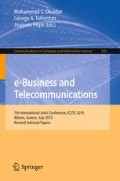Abstract
In this paper, a non-interactive string-commitment protocol in the common reference string model is presented and analyzed. We show that the proposed (length-flexible) commitment protocol realizes the universally composable security in the presence of adaptive adversaries in the standard computational model assuming that the underlying Paillier’s public-key encryption (or Damgård and Jurik’s public-key encryption scheme when a lengthflexible property is claimed) is semantically secure and the Damgård-Fazio- Nicolosi’s non-interactive protocol is zero-knowledge in the registered public-key model.
Access this chapter
Tax calculation will be finalised at checkout
Purchases are for personal use only
Preview
Unable to display preview. Download preview PDF.
References
Barak, B., Canetti, R., Nielsen, J.B., Pass, R.: Universally Composable Protocols with Relaxed Set-Up Assumptions. In: FOCS 2004, pp. 186–195 (2004)
Blum, M.: Coin Flipping by Telephone. In: CRYPTO 1981, pp. 11–15 (1981)
Brassard, G., Chaum, D., Crépeau, C.: Minimum Disclosure Proofs of Knowledge. J. Comput. Syst. Sci. 37(2), 156–189 (1988)
Canetti, R.: Universally Composable Security: A New Paradigm for Cryptographic Protocols. In: FOCS 2001, pp. 136–145 (2001)
Canetti, R., Fischlin, M.: Universally Composable Commitments. In: Kilian, J. (ed.) CRYPTO 2001. LNCS, vol. 2139, pp. 19–40. Springer, Heidelberg (2001)
Canetti, R., Lindell, Y., Ostrovsky, R., Sahai, A.: Universally composable two-party and multi-party secure computation. In: STOC 2002, pp. 494–503 (2002)
Canetti, R., Dodis, Y., Pass, R., Walfish, S.: Universally Composable Security with Global Setup. In: Vadhan, S.P. (ed.) TCC 2007. LNCS, vol. 4392, pp. 61–85. Springer, Heidelberg (2007)
Camenisch, J., Shoup, V.: Practical Verifiable Encryption and Decryption of Discrete Logarithms. In: Boneh, D. (ed.) CRYPTO 2003. LNCS, vol. 2729, pp. 126–144. Springer, Heidelberg (2003)
Damgård, I.B.: On the Existence of Bit Commitment Schemes and Zero-Knowledge Proofs. In: Brassard, G. (ed.) CRYPTO 1989. LNCS, vol. 435, pp. 17–27. Springer, Heidelberg (1990)
Damgård, I., Groth, J.: Non-interactive and reusable non-malleable commitment schemes. In: STOC 2003, pp. 426–437 (2003)
Damgård, I.B., Fazio, N., Nicolosi, A.: Non-interactive Zero-Knowledge from Homomorphic Encryption. In: Halevi, S., Rabin, T. (eds.) TCC 2006. LNCS, vol. 3876, pp. 41–59. Springer, Heidelberg (2006)
Damgård, I., Jurik, M.: A Generalisation, a Simplification and Some Applications of Paillier’s Probabilistic Public-Key System. In: Kim, K.-c. (ed.) PKC 2001. LNCS, vol. 1992, pp. 119–136. Springer, Heidelberg (2001)
Damgård, I., Nielsen, J.B.: Perfect Hiding and Perfect Binding Universally Composable Commitment Schemes with Constant Expansion Factor. In: Yung, M. (ed.) CRYPTO 2002. LNCS, vol. 2442, pp. 581–596. Springer, Heidelberg (2002)
Galil, Z., Haber, S., Yung, M.: Cryptographic Computation: Secure Faut-Tolerant Protocols and the Public-Key Model. In: Pomerance, C. (ed.) CRYPTO 1987. LNCS, vol. 293, pp. 135–155. Springer, Heidelberg (1988)
Goldreich, O.: Foundations of Cryptography, vol. 1. Cambridge University Press (2001)
Goldreich, O.: Foundations of Cryptography, vol. 2. Cambridge University Press (2004)
Goldwasser, S., Micali, S., Rivest, R.L.: A Digital Signature Scheme Secure Against Adaptive Chosen-Message Attacks. SIAM J. Comput. 17(2), 281–308 (1988)
Goldreich, O., Micali, S., Wigderson, A.: How to Play any Mental Game or A Completeness Theorem for Protocols with Honest Majority. In: STOC 1987, pp. 218–229 (1987)
Goldwasser, S., Micali, S.: Probabilistic Encryption. J. Comput. Syst. Sci. 28(2), 270–299 (1984)
Naor, M.: Bit Commitment Using Pseudorandomness. J. Cryptology 4(2), 151–158 (1991)
Naor, M., Ostrovsky, R., Venkatesan, R., Yung, M.: Perfect Zero-Knowledge Arguments for NP Can Be Based on General Complexity Assumptions (Extended Abstract). In: Brickell, E.F. (ed.) CRYPTO 1992. LNCS, vol. 740, pp. 196–214. Springer, Heidelberg (1993)
Paillier, P.: Public-Key Cryptosystems Based on Composite Degree Residuosity Classes. In: Stern, J. (ed.) EUROCRYPT 1999. LNCS, vol. 1592, pp. 223–238. Springer, Heidelberg (1999)
Ryo, N., Keisuke, T., Eiichiro, F.: Efficient Non-Interactive Universally Composable String-Commitment Schemes. In: Pieprzyk, J., Zhang, F. (eds.) ProvSec 2009. LNCS, vol. 5848, pp. 3–18. Springer, Heidelberg (2009)
Peikert, C., Waters, B.: Lossy trapdoor functions and their applications. In: STOC 2008, pp. 187–196 (2008)
Author information
Authors and Affiliations
Editor information
Editors and Affiliations
Rights and permissions
Copyright information
© 2012 Springer-Verlag Berlin Heidelberg
About this paper
Cite this paper
Zhu, H., Araragi, T., Nishide, T., Sakurai, K. (2012). Adaptive and Composable Non-interactive String-Commitment Protocols. In: Obaidat, M.S., Tsihrintzis, G.A., Filipe, J. (eds) e-Business and Telecommunications. ICETE 2010. Communications in Computer and Information Science, vol 222. Springer, Berlin, Heidelberg. https://doi.org/10.1007/978-3-642-25206-8_15
Download citation
DOI: https://doi.org/10.1007/978-3-642-25206-8_15
Publisher Name: Springer, Berlin, Heidelberg
Print ISBN: 978-3-642-25205-1
Online ISBN: 978-3-642-25206-8
eBook Packages: Computer ScienceComputer Science (R0)

